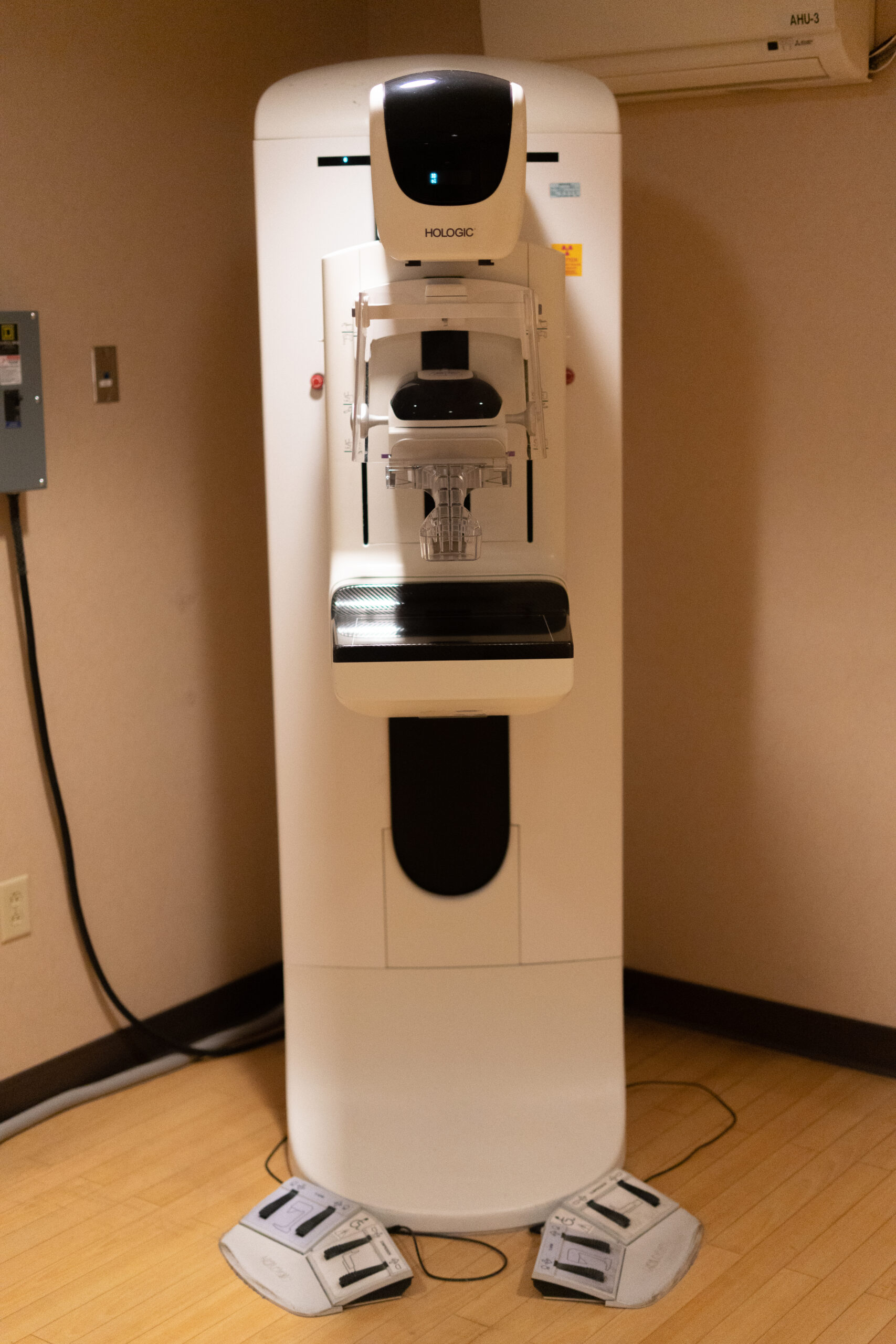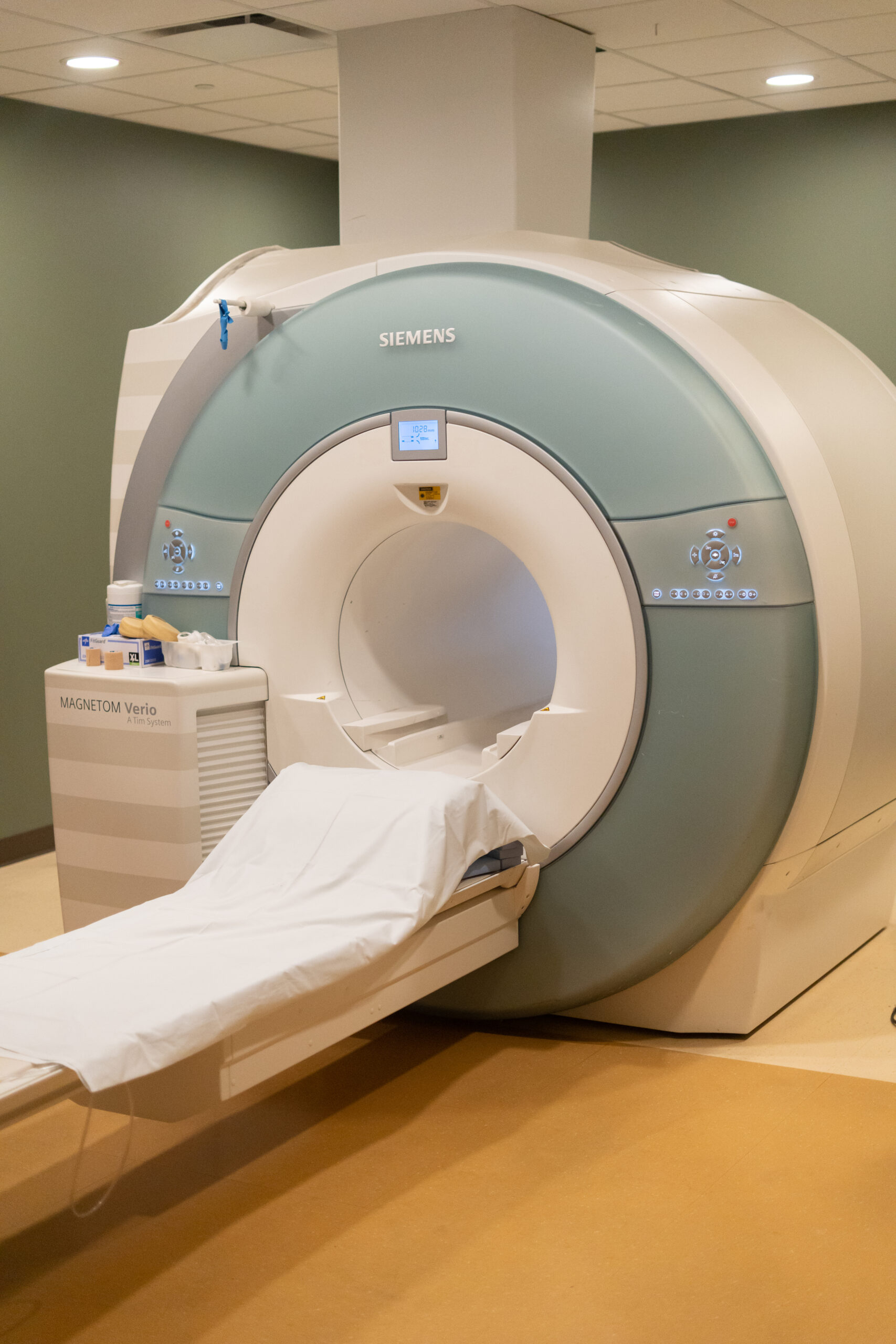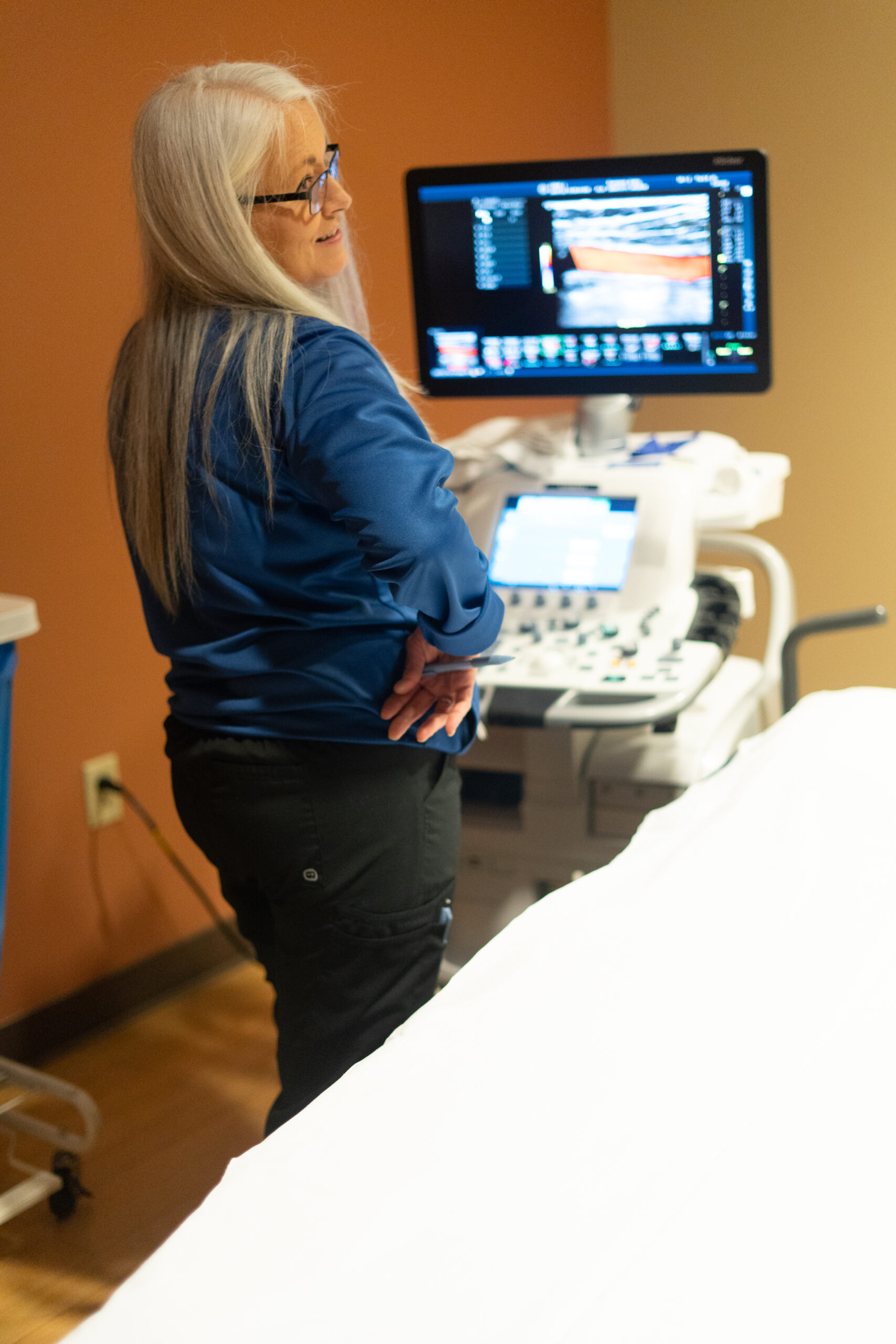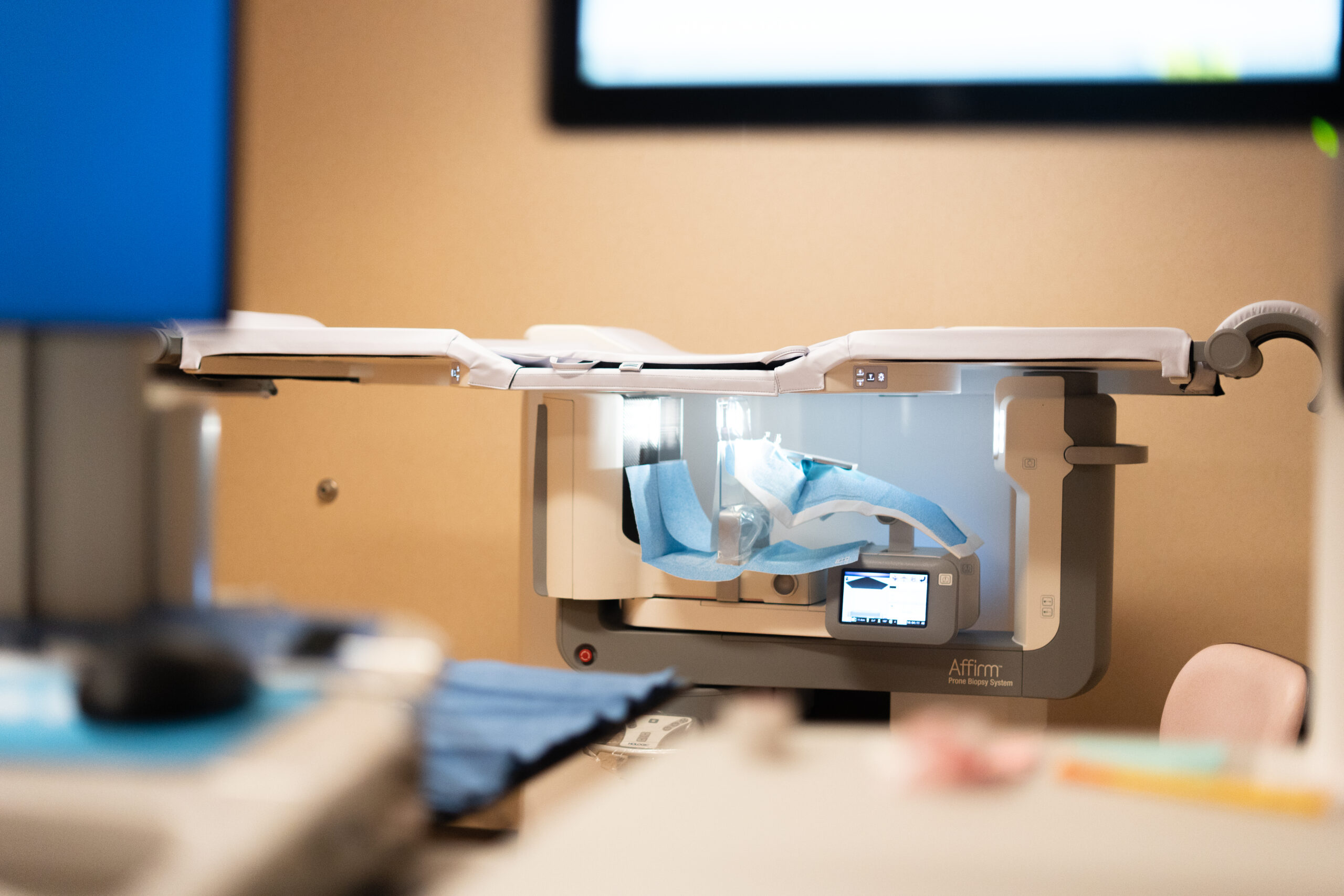The Breast Center's services
The best in breast
care, close to home
Mammography
The Breast Center uses the latest in digital mammography to test for breast abnormalities, including 3D mammography. Digital screening detects cancer 27 percent more often in patients under 50 and those who have dense breast tissue.
Earlier diagnosis, earlier test results and earlier physician viewing of images are some more ways we assist you on your journey to breast health.
3D TOMOSYNTHESIS MAMMOGRAPHY
Over the last several years, there has been a move in technology when it comes to mammograms. Now one can choose to receive a 3D mammogram instead of the traditional 2D mammogram. But what is 3D mammography? What makes it different?
3D mammography produces a three-dimensional view of the breast tissue that helps radiologists identify and characterize individual breast structures by reducing the effect of overlapping tissues.
The benefits of 3D
mammography are:
- Lower radiation dose. With the latest software technology, women will receive a slightly less radiation dose than the standard 2D digital mammogram.
- Reduction in the frequency that women are called back for additional imaging.
- Detection of 41 percent more invasive breast cancers and reduction of false positives by up to 40 percent, according to Hologic Inc.
- Allows doctors to see masses and distortions associated with cancers significantly more clearly than conventional 2D mammography.
All women who would undergo a standard mammogram are candidates for 3D mammograms.
The technology of 3D mammography was approved by the Food and Drug Administration in 2011. Since then, the technology has continued to develop and improve, and more insurance companies are covering this service, as well.


Breast MRI
Cookeville Regional is the only facility in the Upper Cumberland that offers breast MRI services.
MRI is a supplemental tool for detecting and staging breast cancer and other breast abnormalities.
MRI is often used:
- When abnormalities are detected by mammography.
- In women with dense breast tissue or those at high risk.
- In women who have implants or scar tissue.
- To distinguish between scar tissue and recurrent tumors.
- To assess multiple tumor locations.
- To provide additional information to make treatment decisions.
MRI is noninvasive and usually takes an hour. You may receive an injection into the bloodstream so results are more easily viewed.
If you have allergies or there is a possibility that you are pregnant, you should consult your physician before scheduling an MRI. Some conditions such as kidney disease or sickle-cell anemia may prevent you from having an MRI.
Ultrasound
Ultrasound is an important diagnostic tool that complements mammography screening. It can be used to determine if a lump or tenderness in your breast is a fluid-filled cyst or solid lesion. Ultrasounds do not use radiation. If you are under 30, pregnant or lactating, this method may be recommended instead of mammography to screen for breast abnormalities.
Ultrasound may also be prescribed to aid your physician in needle biopsies, cyst aspirations and preoperative wire localization procedures.
The procedure is performed while you are lying face up on a table. You will be asked to wear a mammo cape for the test. The ultrasound technologist will apply a warm, clear gel to the area of your breast being studied, then press a transducer firmly against your skin and move the device slowly back and forth over the suspect area. This produces a real-time image on a screen that can be viewed to identify any abnormalities that may be present.
This procedure is usually completely painless.


Stereotactic Biopsy
When you need a biopsy, The Breast Center offers a less invasive stereotactic procedure that requires a smaller incision than the traditional open surgical method. This outpatient procedure causes minimal scarring and less blood loss than with other methods.
A stereotactic biopsy is sometimes prescribed when an abnormality is identified on a mammogram, ultrasound or other imaging test.
Cookeville Regional is one of the first centers in Tennessee to offer 3D-guided breast biopsy using the Hologic Affirm Prone Breast Biopsy system. This is the world’s first and only dedicated prone biopsy system to offer both 2D and 3D imaging-guided breast biopsies.
The availability of 3D imaging for biopsy guidance facilitates the localization and accurate targeting of lesions, including those that can be challenging to detect with conventional imaging techniques. There are also a number of key advantages over standard x-ray biopsy procedures, including faster targeting and fewer x-ray exposures, resulting in shorter patient procedure time and reduced patient dose.
Stereotactic biopsy is performed while you are lying face down on a table that has an opening for each breast. The breast is slightly compressed – less than is required for a mammogram. A tiny nick is made in the numbed skin and a pencil-sized device is guided to the targeted area. A small sample of the breast tissue is removed and sent to the laboratory for analysis. The entire procedure takes about one hour.
Aspirin products should not be taken for several days prior to the procedure. If you are on prescription blood things you will need to consult your physician prior to scheduling the biopsy.
The Breast Center staff seeks to create a warm and compassionate environment while your test is being performed and we will answer any questions you have concerning your test and its results. Our nurse navigator is also available to answer any questions.
Bone Density Testing
Osteoporosis weakens the bones to the point that they break easily, especially bones in the hip, spine and wrist. It is called the silent disease because symptoms do not occur until the disease is in an advanced stage.
The Breast Center offers the Horizon DXA system from Hologic, which offers superb visualization, unparalleled speed and precision, and uses the most leading-edge technology available today. Osteoporosis is a growing health concern and while the new Horizon DXA system generates crisp, clear, high-resolution images to accurately assess bone density for patients at risk for osteoporosis, it can do so much more.
Features include:
Atypical femur fracture assessment. This system produces radiographic quality images of the entire femur for assessment of potential atypical femur fractures. A quick, 15-second scan reveals cortical thickening of the bone, making it fast and easy to monitor the effects of biophosphonate therapy over time.
Abdominal aortic calcification. This system allows the visualization of calcified plaque in the abdominal aorta, which may be a significant indication of heart disease and/or stroke – two of the leading causes of death in men and women.
Instant vertebral assessment scan. This determines the fracture risk by combining an accurate assessment of bone density with high-resolution vertebral imaging. Spine fractures can be identified with a low-dose, single-energy image in 10 seconds. This is recommended for patients with a T-score less than 1.0 or any one or more of the following:
Women 70 years or older or men 80 years or older.
Height loss of more than 1.5 inches
Self-reported but undocumented prior vertebral fractures
Glucocorticoid therapy equivalent to less than or equal to 5 mg of prednisone per day for more than three months.
Advanced body composition assessment. This system can complete a full body scan providing detailed information, including patients’ percentage of body fat, percentage of lean mass and visceral fat to provide more detailed information than a BMI calculation.
Overall, women are at greater risk than men for developing osteoporosis. However, several factors can increase a woman’s risk.
If you:
- Are postmenopausal.
- Have a family or personal history of spine or hip fracture after age 45.
- Are of Caucasian or Asian race.
- Are small-boned and weigh less than 127 pounds.
- Have experienced early menopause or cessation of menstruation before menopause.
- Have a lifestyle with little or no exercise, especially weight-bearing exercise.
- Have a history of alcohol abuse or smoking cigarettes.
- Have a history of long-term use of glucocorticoids (oral steroids).
- Use medications to treat hyperthyroidism, marrow disorders, collagen disorders, gastrointestinal problems and seizure disorders.